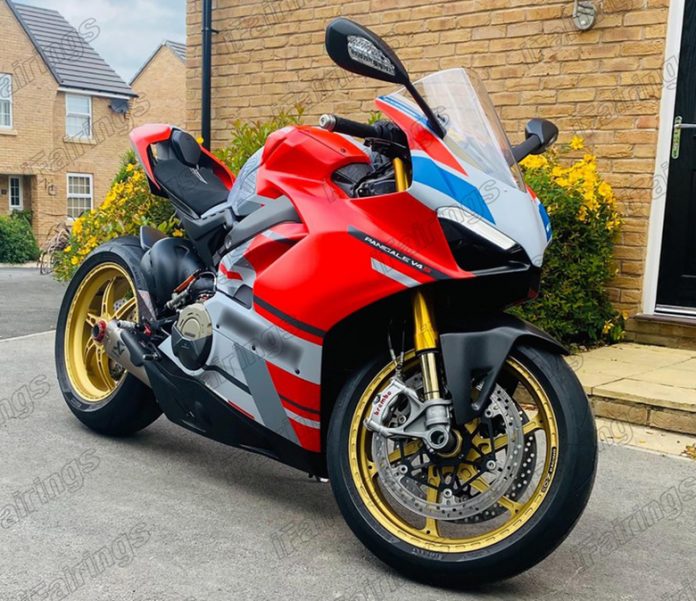As a result of close cooperation with Ducati Corse, the Ducati 2019 Panigale V4S Course Sports Bike has been created to produce a road bike that is as similar as possible in terms of performance to its MotoGP equivalent.
It is a Panigale V4. An all-new “symphony” of Italian performance and passion, the Diavel is a thrilling new chapter in the Ducati saga. For the first time, Ducati has put a four-cylinder engine in a production motorbike, and it comes from the MotoGP Desmosedici. It’s a total of Ducati technology, flair, and power. The new Corse livery, inspired by the colors of the MotoGP motorcycles, is available for the 2019 model year on the 1,103cc Corse, which establishes a new benchmark in the supersport production bike market with a power/weight ratio of 1.1 hp/kg.
Ducati 2019 Panigale V4S Course Sports Bike – Features and Specs
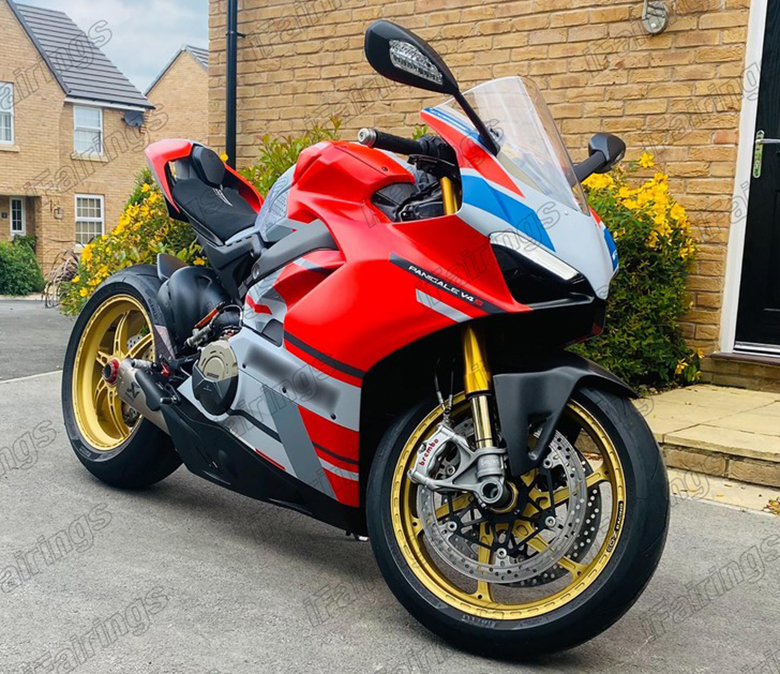
Ducati V4 Engine
V4 engines are considered the peak of the motorcycle engine performance by Ducati. It’s not a coincidence that Desmosedici MotoGP engines use the same solution. Because of the 90-degree V configuration, it is unnecessary to use a balancing countershaft to equalize the first-order forces, adding weight and power. This advantage is only one of several that make this Ducat-selected configuration the most technically sophisticated feasible for an engine that can rev as high as 14,000 rpm.
The V arrangement’s lateral compactness improves mass centralization and minimizes the bike’s frontal cross-section compared to a standard in-line 4. It is also less gyroscopic since the crankshaft is shorter than it used to be. You’ll notice a noticeable improvement in performance due to these factors. The Desmosedici Stradale has a 12.8-liter airbox because of the V’s ample capacity for both the water pump and the airbox.
The core of every Ducati is a well-integrated engine and chassis set-up. Desmosedici Stradale is meant to bank back 42 degrees, much as the MotoGP engines used by Ducati. With the swingarm. Pivot positioned as far in front as feasible; this improves weight distribution and frees up space for more oversized radiators.
In addition, the Desmosedici Stradale was developed as a component of the chassis. The top crankcase half’s front and the rear cylinder bank head’s connection points for the mainframe are integrated. In addition, the crankcase serves as a swing arm—connection point for the rear suspension.
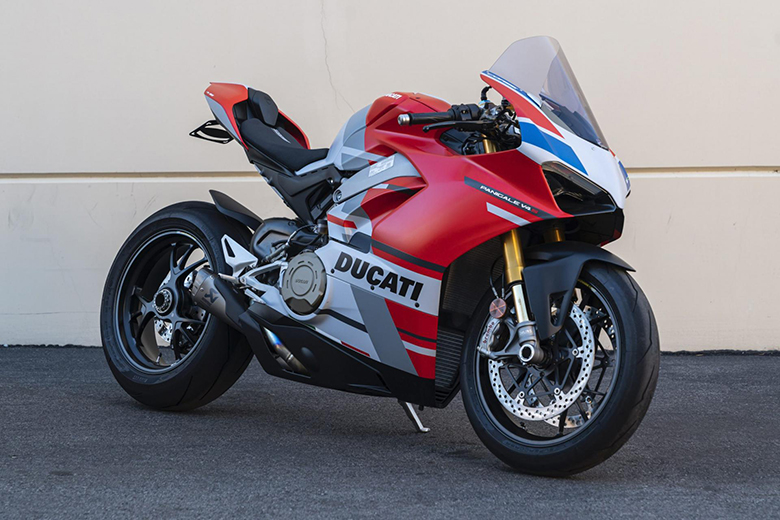
Light and Compact
The collaboration with Ducati Corse has resulted in a light, compact, and powerful engine. Ducati’s engine team has worked meticulously to create a power delivery system that is comfortable to ride on the road and speedy on the track.
By comparison, the Desmosedici Stradale weighs only 2.2 kg more than the 1,285 cm3 Superquadro twin, showing how vital weight savings are to Ducati projects.
Gravity die-cast aluminum engine shells are horizontally linked. The four Nikasil-coated aluminum cylinder liners are incorporated into the upper crankcase half, guaranteeing wear prevention and reduced friction.
Two brand new low-attrition compression rings and an oil ring are used on the 81 mm pistons that slide within the liners. Molded aluminum pistons are equipped with a “box in a box” design, which helps to decrease wear and inertia while still providing the essential rigidity and strength.
In addition to its racing-inspired appearance, this engine has a compression ratio of 14:1. Forged steel con rods having a center-to-center distance of 101.8 mm connect the pistons to the crankshaft. Three brass bushings support the crankshaft, constructed of nitrided steel with crankpins ground twice and offset at 70 degrees like the Desmosedici engines that participate in MotoGP.
A “Twin Pulse” ignition sequence is possible because of the V engine’s unique shaft shape. Die-cast magnesium is used for all engine casings to keep the engines light. The cam covers, alternator cover, oil sump, and two-piece clutch cover are all the same material.
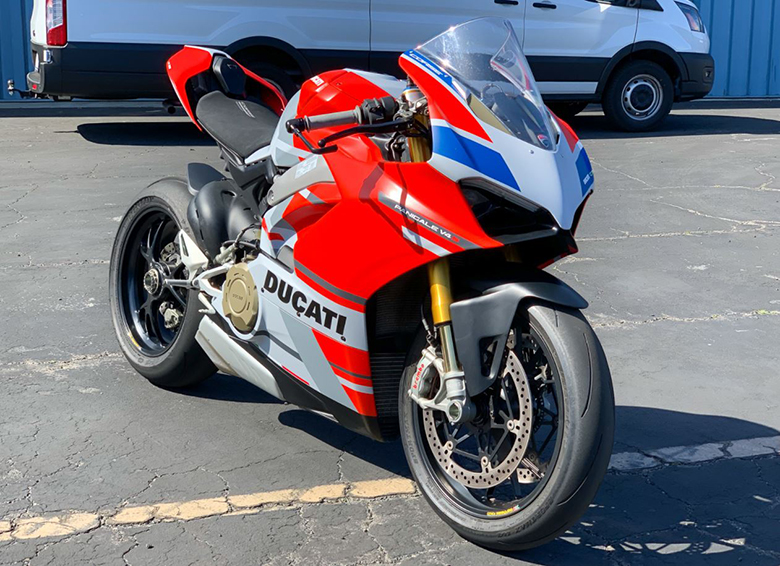
Cooling System
A shaft and gear system power the water pump in the engine ‘V.’ It is aimed to reduce circuit size, increase efficiency, and minimize the engine’s weight.
Gearbox and Clutch
Designed for the Desmosedici Stradale engine, the 6-speed gearbox has a rotating gear sensor that ensures the proper functioning of the DQS up and downshifts.
Gear shift drum position and fork position are determined by a sensor with great precision, ensuring a perfect selection of gears. In this method, a plan may be devised only to restore torque transmission once the gear change is complete, minimizing unnecessary stress on the gear mesh and ensuring that gear changes are accurate and quick.
Wet clutches with hydraulic control include 11 driving plates and a progressive self-servo system that compresses the friction plates. At the same time, the engine moves them without the rider having to make any further effort.
The outcome is a more “rider-friendly” and “light” clutch lever “feel” while improving frictional efficiency. With the extra advantage of a super-responsive lever, the same system minimizes friction plate pressure for a pure racing “slipper” motion while also decreasing rear-end destabilization during rapid downshifting.
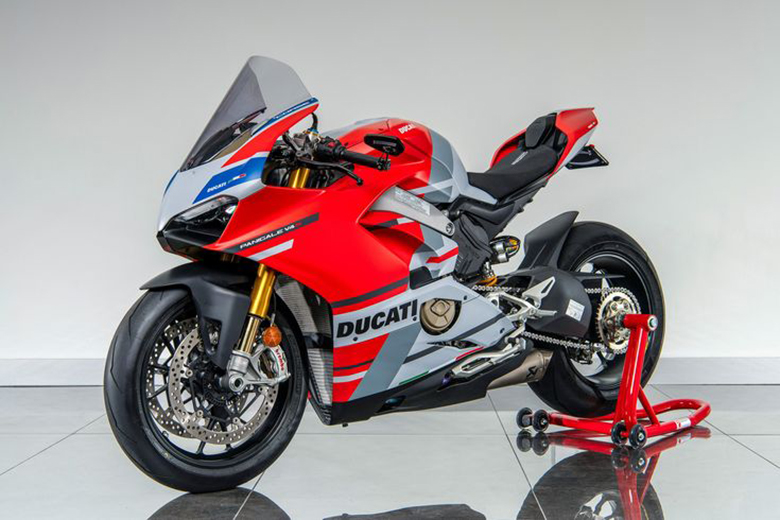
Long Maintenance Intervals
General Service intervals remain unaltered at 12 months/12,000 kilometers, despite the car’s performance surpassing even that of the Superquadro. The valve clearance examination and adjustment (Desmo Service) frequency continues at 24,000 kilometers (15,000 miles) (7,500 miles).
Innovative Front Frame
Specifications like the curb weight of 195 kg for the “S” and Speciale variants demonstrate the new Panigale V4’s racing spirit (only 5.5 kg more than the 1299 Panigale S). Using a typical perimeter frame would be ineffective in achieving these results. “Front Frame” has been designed, employing the Desmosedici Stradale engine as a load-bearing component, to address this issue based on MotoGP’s extensive knowledge in monocoque design, this new approach was designed.
Comparatively speaking, the “Front Frame” design enables torsional and lateral stiffness to be maintained distinct from the monocoque, giving the essential stability and providing the proper reaction to stress imparted to the frame. The Panigale V4 rider will be able to manage the bike more efficiently and with less fatigue due to all of this.
The engine is used as a structural component of the frame, unlike standard perimeter frames. It weighs just 4 kilograms and has a compact frontal construction attached directly to the top half-crankcase of the front cylinder head and the V4 rear cylinder head, with the engine also serving as a point of fixation for the rear suspension a pivot for the single-sided swingarm.
Because the Desmosedici Stradale engine can be employed to generate needed stiffness, the Ducati “Front Frame” may drastically lower the main frame’s outreach and weight, leading to an improved rigidity/weight ratio. An additional perk of this design is the smaller seat space because of the shorter lengths of the pillars running beside the engine.
The shell-cast aluminum seat sub-frame is attached to the “Front-Frame” at the top and the top of the brand new rear cylinder head at the bottom of the “Front-Frame” sub-frame.

A forged aluminum element connects the Desmosedici Stradale engine to the rear suspension, including a rising-rate linkage system. To provide the optimum performance coming out of corners, the linkage reacts to the motion conveyed via a 600 mm long high-triangulation cast aluminum single-sided swingarm.
Ducati 2019 Panigale V4S Course Sports Bike – Technical Specifications
Engine
| Type | Desmosedici Stradale 90-degree V4, rearward-rotating crankshaft, 4 Desmodromically |
| Displacement | 1,103cc |
| Bore x stroke | 81mm x 53.5mm |
| Compression ratio | 14.0:1 |
| Power | 157.5 kW (214 hp) at 13,000rpm |
| Torque | 124Nm (91.5 lb-ft) at 10,000rpm |
| Fuel injection | Electronic fuel injection system. Twin injectors per cylinder. Entire ride-by-wire elliptical throttle bodies. The variable-length intake system |
| Exhaust | 4-2-1-2 system, containing two catalytic converters and two lambda probes |
| Gearbox | Six speed with Ducati Quick Shift (DQS) up/down EVO |
| Primary drive | Straight cut gears; Ratio 1.80:1 |
| Final drive | Chain; Front sprocket 16; Rear sprocket 41 |
| Clutch | Hydraulically controlled slipper & self-servo wet multiplate clutch |
Chassis
| Frame | Aluminum alloy “Front Frame”. |
| Front suspension | Öhlins NIX30 43 mm fully adjustable fork having TiN treatment. Electronic compression and rebound damping adjustment including Öhlins Smart EC 2 event-based mode |
| Front-wheel | 3-spokes forged aluminum alloy 3.5-inch x 17-inch |
| Front tire | Pirelli Diablo Supercorsa SP 120/70 ZR17 |
| Rear Suspension | Fully adjustable Ohlins TTX36 unit. Electronic compression & rebound damping adjustment having Öhlins Smart EC 2.0 event-based mode. Aluminum single-sided swingarm |
| Rear Wheel | 3-spokes forged aluminum alloy 6-inch x 17-inch |
| Rear tire | Pirelli Diablo Supercorsa SP 200/60 ZR17 |
| Wheel travel (front/rear) | 120mm (4.7 inches) – 130mm (5.1 inches) |
| Front brake | 2 x 330mm of semi-floating discs, radially fixed Brembo Monobloc Stylema® (M4.30) 4-piston calipers with Bosch Cornering ABS EVO |
| Rear brake | 245 mm disc, 2-piston caliper with Bosch Cornering ABS EVO |
| Instrumentation | Last generation digital unit including 5-inch TFT color display |
Dimension
| Dry weight | 174 kg (384 lb) |
| Curb weight | 195 kg (430 lb) |
| Seat height | 830 mm (32.7 inches) |
| Wheelbase | 1.469 mm (57.8 inches) |
| Rake | 24,5° |
| Front-wheel trail | 100 mm (3,94 in) |
| Fuel tank capacity | 16 l – 4.23 gallon (US) |
| Number of seats | Single-seat |
Other Equipment
| Safety equipment | Riding Modes, Power Modes, Bosch Cornering ABS EVO, Ducati Traction Control (DTC) EVO, Ducati Wheelie Control (DWC) EVO, Ducati Slide Control (DSC), Engine Brake Control (EBC) EVO, Auto tire calibration |
| Standard equipment | Ducati Power Launch (DPL), Ducati Quick Shift (DQS) up/down EVO, Full LED lighting with Daytime Running Light (DRL), Ducati Electronic Suspension (DES) EVO with Ohlins suspension and steering damper, Quick adjustment buttons, Lithium-ion battery, Auto-off indicators, Marchesini aluminum forged wheels, Carbon fiber front/rear mudguards, Machined-from-solid top yoke with an identification number, Alcantara® seat, Dedicated handle grips, Adjustable footpegs, Carbon fiber heel guard, Carbon fiber cover swinging arm, Racing articulated levers, Brake level protection |
| Additional equipment | Ducati Performance by Akrapovic Titanium full-racing exhaust system, Racing windshield, Machined mirror block-off plates, License plate mount removal plug, Ducati Data Analyser+ (DDA+) with GPS module, Racing fuel tank cap, Paddock bike cover |
| Ready for | Ducati Multimedia System (DMS) and anti-theft |
| Warranty (months) | 24 months unlimited mileage |
| Maintenance (km/months) | 12,000 km (7,500 mi) / 12 months |
| Valve clearance adjustment (km) | 24,000 km (15,000 mi) |
Emission Standards
| Standard | Euro 4 |
| Consumption | Consumption = 6,9 l/100km |
| CO2 Emissions | CO2 = 165 g/km |

